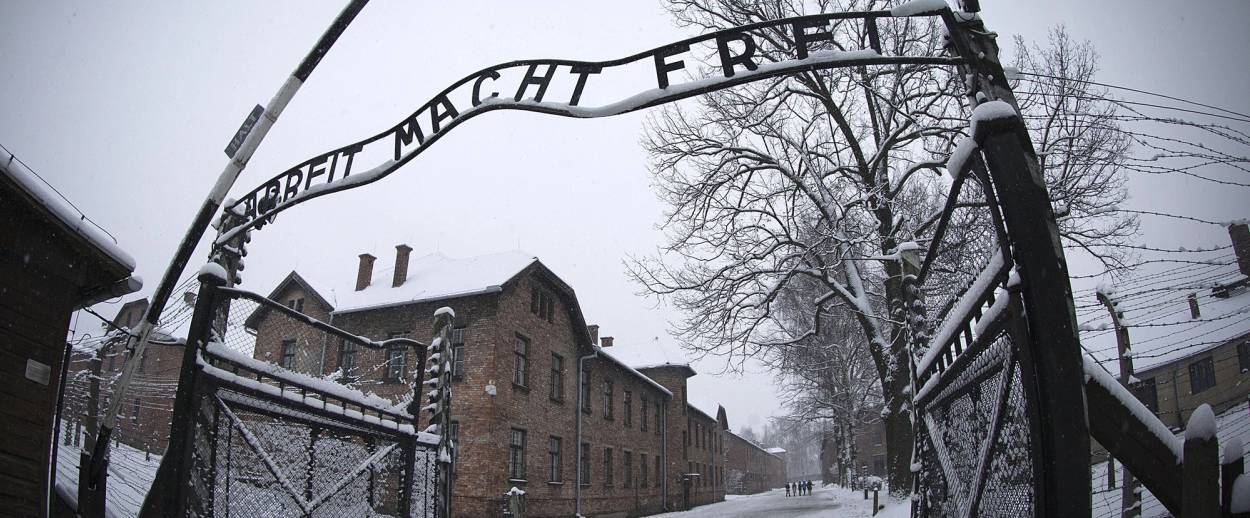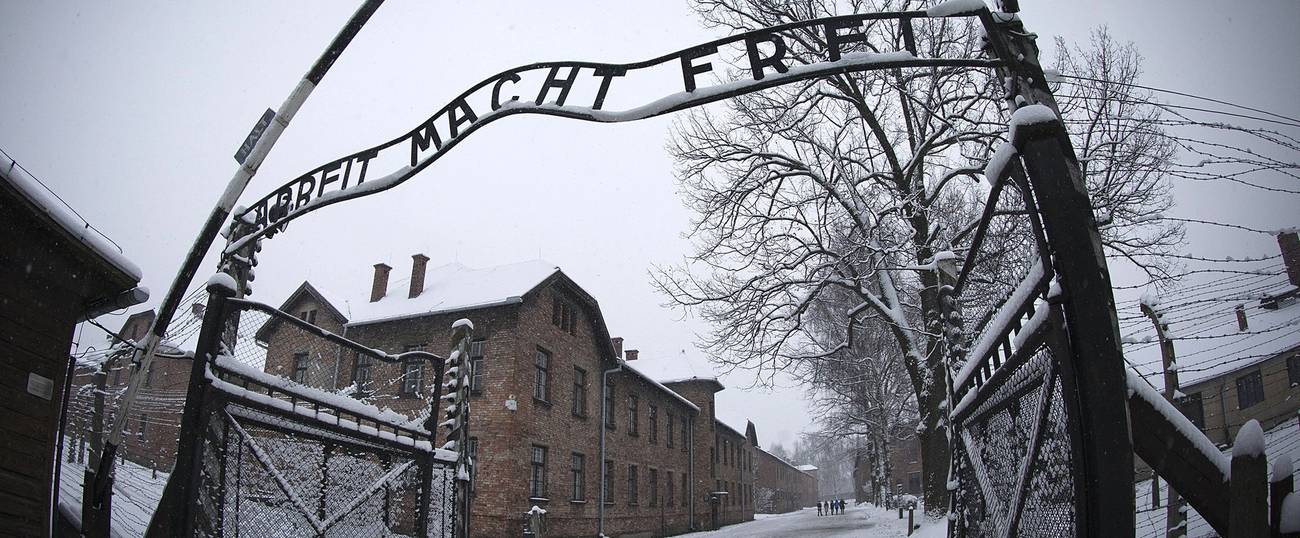Hitler’s Secret Weapon Was Coercing Jews to Destroy Themselves
Will we do it again?




These days have been emotionally challenging. For the past two weeks, in preparation for a planned anti-genocide center, I’ve traveled with my family on an educational journey through the killing fields of Germany and Eastern Europe, the idea being to truly immerse myself in the dark, hallowed sites of the Holocaust so as to better understand genocide, its psychology, and its causes. And beyond every consideration, there is that of memory, of never forgetting the lost martyrs of my people.
We began in Berlin where we visited the Wannsee House, where Nazi leaders sat over caviar and cigars to fine-tune the details of the Final Solution and enact the extermination of European Jewry. From there we traveled to Prague, where we saw the wistful remains of a mighty Jewish community ravaged by Reynard Heidrich during his time as Reich-protector of Bohemia (an ironic title if ever there was one). We continued eastward into Poland, where we visited Auschwitz, Treblinka, and Majdanek, where 43,000 Jews would be killed in the Holocaust’s largest single day, single camp massacre on Nov.15, 1944.
We visited Bialystok, where we saw the skeleton of the city’s once-legendary synagogue, beneath which 2,000 Jews were burned alive. We visited Tykocin, where the village’s Jews, possessed of a 400-year-old synagogue, were marched into the woods and massacred. We visited the ghettos of Warsaw, Lodz, and Krakow, cities that still flutter with the ghosts of the multitudes lost from within. From there we went to Kosice, from which my wife’s family stems, and the last place her great-uncle was seen before he, too, was murdered by the Nazis in an unknown location in Poland. We went to Austria, where in Linz we saw Hitler’s childhood home, his parents’ burial plot, and, not far from there, the Mauthausen concentration camp.
I knew this trip wouldn’t be easy, but I could never have known just how gut-wrenching it could be. The true sense of hopelessness that haunts the air over these sites can be felt only when one is actually present.
The Holocaust remains a crime that boggles the imagination, a tragedy that is as mysterious as it is horrifying. I’ve read dozens of books on the subject, most recently Lawrence Rees’s outstanding work, The Holocaust. Taken together, these thorough studies map out the figures, methods, and very mechanics of the Nazi slaughter. But what I failed to grasp even after such extensive reading was a profound understanding of just how the Nazis believed they could actually succeed in slaughtering an entire nation across an entire continent— all while at war with much of the known world. How could they possibly have set out on a plan of murder so vast that it defies all logic? How did they think they even had the wherewithal to pull it off?
Though tormenting in the extreme, I believe this journey has given me a clue. The Nazis, I have come to understand, would eradicate the Jewish nation by always holding out the possibility that, against most of the evidence, some might still live. The Jews were led to believe that if they just cooperated, their children would survive. They could not believe that Hitler would be hateful enough to eradicate an entire nation which could be used for labor in a time of war. A hatred this extreme and so utterly self-destructive had no precedent in world history. Cognitive dissonance played a further role, and the Jews could simply not accept that the Nazis intended their total annihilation.
At almost every step of the way, the Jews were forced into cooperating with the very plans drawn up to exterminate them. The Jews, the Germans thought, could provide the manpower the Nazis lacked only if they could be persuaded that if they went along with the program they would be put to productive work. Knowing that the Jews were simply trying to live, the Nazis would dangle the possibility of survival before Jewish eyes at every turn. Thus would the Jewish communities of Poland and Eastern Europe be forced into obeying Nazi orders to herd themselves into ghettos, administrate their cordoned-off ghetto communities, and board their families at the threat of rifle butts and bullets onto cattle-cars. The Nazis would bring these Jews to their deaths all by exploiting their most elemental desire for them, and especially their families, to live.
The Nazis forced the Jews to create their own self-administering councils, Judenrats, in the ghettos. When visiting the Lodz Ghetto, I stood at the exact spot where Chaim Rumkowski gave his notorious “Give Me Your Children” speech in September of 1942. As chairman of the Lodz Judenrat, Rumkowski had decided to turn the ghetto into a factory, believing that only by being useful to the Nazis could its inhabitants be spared. However, the Nazis began to demand quotas of Jews to be deported to their deaths—quotas Rumkowski himself was forced to fill. In September 1942, he begged the mothers of the ghetto to give up their children, whom, in being unproductive, he expected to be killed in any event. Though the mothers refused, Rumkowski and his Jewish agents rounded up 24,000 Jews under 10 and over 65, forced at the pain of death to do much of the Nazis’ work for them. Untold numbers of suicides followed his speech.
Of course, it was all deception. The entire Lodz ghetto would be liquidated beginning in August of 1944, and of the 223,000 Jews who had lived there, only 877 would remain by the time the Red Army arrived in January 1945. The rest would be sent to their deaths in the gas chambers at Chelmno and Auschwitz. Rumkowski himself would be deported to Birkenau. He, however, would not make it to the gas chambers. He was, upon arrival, beaten to death by his fellow inmates, at least according to prevailing eye-witness accounts.
In the camps themselves, the Jews were forced into Sonderkommando units, where Jewish inmates were put to work disposing of the millions of bodies left lifeless in the gas chambers. They too were threatened with constant death, yet were twinned with a chance at life so long as they complied with the Nazi program. This too was a lie. The Nazis had a policy at their death camps of gassing the entire corps of Sonderkommando every three months. Unbeknownst to the incoming ranks of the desperate Sonderkommando, the first victims they’d be asked to incinerate would be the generation that had worked there before them.
But where this message was imparted to me most strikingly was on a placard posted at the new and outstanding Jewish Museum in Warsaw. Upon a beige slab set into the wall read some of the most haunting words I have ever seen. It was an extremely rare written testimonial of a Sonderkommando, found hidden at Auschwitz, who was describing the look on the faces of the Jews as they entered the gas chambers. In words I can only quote:
Fear permeated everyone to the marrow … those people locked inside … they tore their hair out, realizing that they had been so naive as to allow themselves to be led here, within these locked doors. Their voices rising to the heaven gave vent to their spirit in the only way they could; they let out their last great scream of protest against this greatest of all injustices meted out against the entirely innocent.
The look he perceived was not only one of fear and terror, but also one of a startling realization of the Nazis forcing the Jews to collude in their deaths. The Jews had been murdered amid the hope that some might survive, that a fate as gruesome as a gas chamber was a simple impossibility. But it was all a grotesque fabrication. The Germans’ intention was the utter destruction of the Jews of Europe, even if still today we can scarcely believe it.
The Jews had been forced to follow all Nazis orders in the hope of living. They had been forced to abandon their homes, give up their businesses, relocated to the squalor of the ghetto, work in inhumane conditions of slave-labor, watch their friends and family starve to death, board cattle-cars to the camps, watch as their family and friends were shot in the backs of their heads, and undergo selections as to who would live and who would die. They had been forced to surrender completely to the Nazi genocide program all while being told they and their children might still live.
But it was all a mass deception. The Nazis were not only the greatest murderers of all time. They were also the greatest liars who ever lived.
As painful as it is to face such horrors, I believe this theme imparts to us a crucial lesson.
If we hope to prevent the recurrence of genocide in our world, we have to learn from our martyred brethren, the heroic Jews of Europe who did everything to keep their children alive. First and foremost, this means fighting back against those threatening genocide long before the slaughter ever starts. When it comes to evil, we must be overly-vigilant, hypercautious, and have no tolerance for risk. For in even a fragment of naiveté toward the plans of evil men lies the greatest danger. After all, one cannot prevent what one does not imagine could ever occur.
At Treblinka, we saw the signs the Germans used to portray the camp as nothing but a train stop on the way to the East, where the Jews would be used for productive labor. Even here, where the trains ended at hell on Earth, the Nazis still thought they could leverage the Jewish will to live by convincing them that they were en route to a productive life.
This lesson is especially critical for the State of Israel, a nation founded on the premise of finally providing the Jewish people with a bastion of security. Israel is constantly criticized for reacting too quickly and disproportionately to the genocidal threats that face it. But in light of what I’ve witnessed in the killing fields of Europe, such intolerance of risk is entirely justified.
With Iran calling for a second Holocaust in the state of Israel—threatening constantly as they do to raze Israeli cities to the ground and wipe Israel off the map—Israel must react to its threats before they can be realized. Genocidal rhetoric in our time must be something that is resisted completely. In Rwanda too, the Hutus called the Tutsis “cockroaches” well before launching their genocide campaign.
So too with regard to Hamas and even the Palestinian Authority. We cannot cede land for a Palestinian State in the hope of demographic survival when in doing so we might find ourselves in a three-front war from Gaza, Judea, and Samaria in the West Bank, and Lebanon aimed at Israel’s annihilation. Israel simply cannot afford even the slightest risk of being deceived into walking toward its own demise, all in the promise of peace by those who speak openly of a new genocide of the Jews. Peace will come only when all genocidal rhetoric and intent is purged completely.
We must stand strong, and show the world that we have learned from the horrors of our history. This time, we simply will not rely on others to safeguard our lives or prevent our deaths.
***
Like this article? Sign up for our Daily Digest to get Tablet Magazine’s new content in your inbox each morning.
Rabbi Shmuley Boteach is the founder of The World Values Network and the author of 31 books. Follow him on Twitter @RabbiShmuley.